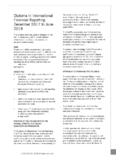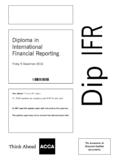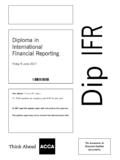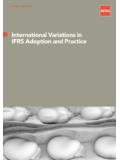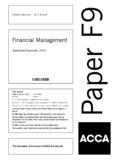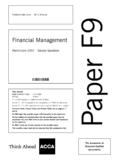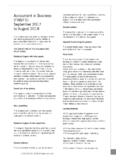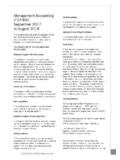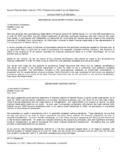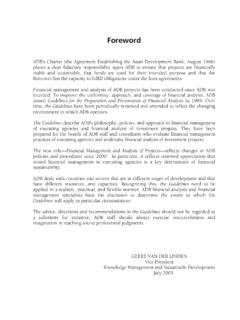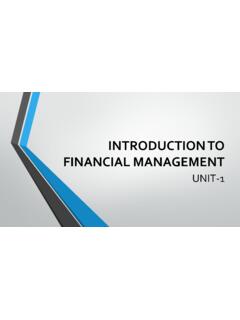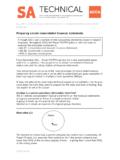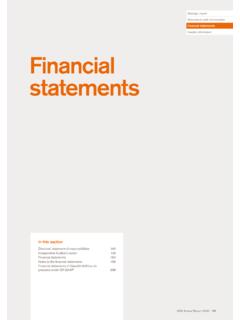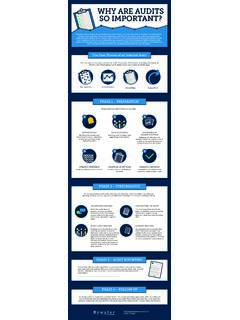Transcription of Recording Financial Transactions (FA1)
1 ACCA 2019-2020 All rights FinancialTransactions (FA1) Syllabus and study guideSeptember 2019 to August 2020 ACCA 2019-2020 All rights OF hours and educational to ACCA examination to ACCA examination assessmentRECORDING Financial diagram linking RecordingFinancial Transactions with other aim of the to examining the syllabusRECORDING Financial Transactions study of changes to Recording FinancialTransactions ACCA 2019-2020 All rights LEVELSACCA qualifications are designed to progressivelybroaden and deepen the knowledge and skillsdemonstrated by the student at a range of levelsthrough each , the study guides assess bothknowledge and skills. Therefore a clear distinction isdrawn, within each subject area, between assessingknowledge and skills and in assessing theirapplication within an accounting or businesscontext. The assessment of knowledge is denoted bya superscriptKand the assessment of skills isdenoted by the HOURS AND EDUCATIONALRECOGNITIONAs a member of the International Federation ofAccountants, ACCA seeks to enhance the educationrecognition of its qualification on both national andinternational education frameworks, and witheducational authorities and partners globally.
2 Indoing so, ACCA aims to ensure that its qualificationsare recognized and valued by governments,regulatory authorities and employers across allsectors. To this end, ACCA qualifications arecurrently recognized on the education frameworks inseveral countries. Please refer to your nationaleducation framework regulator for furtherinformation about TO ACCA EXAMINATIONSTRUCTURE AND DELIVERY MODEThe structure of examinations Foundations examinations contain 100%compulsory questions to encourage candidates tostudy across the breadth of each Foundations examinations are assessed by two-hour computer based pass mark for all FIA examinations is 50%. TO ACCA EXAMINATIONASSESSMENTACCA reserves the right to examine anythingcontained within any study guide within anyexamination session. This includes knowledge,techniques, principles, theories, and concepts specified Financial accounting, audit and taxexaminations, except where indicated otherwise,ACCA will publishexaminable documentsonce ayear to indicate exactly what regulations andlegislation could potentially be assessed withinidentified examination this examination regulationissuedor legislationpassedon or before 31stAugust annually, will beassessed from September 1stof the following year toAugust 31stof the year after.
3 Please refer to theexaminable documents for the exam (whererelevant) for further issued or legislation passed inaccordance with the above dates may beexaminable even if theeffectivedate is in the term issued or passed relates to whenregulation or legislation has been formally term effective relates to when regulation orlegislation must be applied to entity transactionsand business study guide offers more detailed guidance onthe depth and level at which the examinabledocuments will be examined. The study guideshould therefore be read in conjunction with theexaminable documents list. ACCA 2019-2020 All rights STRUCTUREThe qualification structure requires candidates who wish to be awarded the ACCA Diploma in Financial andManagement Accounting (RQF Level 2) to pass both the FA1 and MA1 examinations and successfully completethe Foundations in Professionalism DIAGRAM LINKING Recording Financial Transactions WITH OTHER EXAMSThe FIA suite of qualifications is designed so that a student can progress through three discrete levels; RQF Level2, 3, and 4.
4 However, entry is possible at any point. Students are recommended to enter Foundations inAccountancy at the level which is most appropriate to their needs and abilities and to take examinations in order,but this is not a requirement. ACCA 2019-2020 All rights AIM OF THE SYLLABUSTo develop knowledge and understanding of themain types of business Transactions anddocumentation and how these are recorded in anaccounting system up to the trial balance syllabus for FA1, Recording FinancialTransactions, introduces the candidate to thefundamentals of preparing and Recording financialdocumentation from originating documents andprocessing ledger Transactions up to the trialbalance stage. It also covers relevant bankingprocedures associated with bookkeeping,maintaining and reconciling cash and petty cashrecords and preparing the journal and relevantcontrol accounts and identifying and correctingerrors.
5 ACCA 2019-2020 All rights CAPABILITIESOn successful completion of this exam, candidates should be able to explain and understand the following:ATypes of business Transactions and documentationBDuality of Transactions and the double entry systemCBanking system and transactionsDPayrollELedger accountsFCash and bankGSales and credit transactionsHPurchases and credit transactionsIReconciliationJPreparing the trial balance ACCA 2019-2020 All rights TO EXAMINING THESYLLABUSThe syllabus is assessed by a two hour computer-based examination. Questions will assess all parts ofthe syllabus and will include both computationaland non-computational elements. The examinationwill consist of 50 two mark SYLLABUSAT ypes of business Transactions of business of business of Recording business transactionswithin the accounting systemBDuality of Transactions and the double of prime entry of Financial statementsCBanking system and banking payroll Transactions into theaccounting systemELedger ledger accountsFCash and a a petty cashbookGSales and credit account balances and controlaccountsHPurchases and credit balances and of control accounts and the the receivablescontrol the payables control accountJPreparing the trial the trial errors ACCA 2019-2020 All rights STUDY GUIDEATYPES OF BUSINESS TRANSACTION of business transactiona)Understand a range of business transactionsincluding.
6 [K]i)Salesii)Purchasesiii)Receiptsiv)Pay mentsv)Petty cashvi)Payrollb) Understand the various types of discountincluding, where applicable, the effect thattrade discounts have on sales tax.[K]c) Describe the processing and security proceduresrelating to the use of:[K]i)Cashii)Chequesiii)Credit and debit cardsiv)Debit cards for receipts and payments andelectronic payment of business documentationa)Outline the purpose and content of a range ofbusiness documents to include but not limitedto:[K]i) Invoiceii) Credit noteiii) Remittance adviceb)Prepare the Financial documents to be sent tocredit customers including:[S]i) Sales invoicesii) Credit notesiii) Statements of accountc)Prepare remittance advices to accompanypayments to suppliers.[S]d)Prepare a petty cash voucher including thesales tax element of an expense whenpresented with an inclusive amount.[S] of Recording business transactionswithin the accounting systema)Identify the characteristics of accounting dataand the sources of accounting data records,showing understanding of how the accountingdata and records meet the business requirements.
7 [K]b)Understand how users locate, display andcheck accounting data records to meet userrequirements and understand how data entryerrors are dealt with.[K]c)Outline the tools and techniques used toprocess accounting Transactions and period-endroutines and consider how errors are identifiedand dealt with.[K]d)Consider the risks to data security, dataprotection procedures and the storage ofdata.[K]e)Understand the principles of coding in enteringaccounting Transactions including:[K]i)Describing the need for a coding system forfinancial Transactions within a double entrybookkeeping systemii)Describe the use of a coding system withina filing systemf)Code sales invoices, supplier invoices andcredit notes ready for entry into the books ofprime entry.[S]g)Describe the accounting documents andmanagement reports produced bycomputerised accounting systems andunderstand the link between the accountingsystem and other systems in the business.
8 [K]BDUALITY OF Transactions AND THEDOUBLE ENTRY of prime entrya)Outline the purpose and content of the booksof prime entry including their format.[K]b)Explain how Transactions are entered in thebooks of prime entry.[K] ACCA 2019-2020 All rights )Outline how the books of prime entry integratewith the double entry bookkeeping system[K]d)Enter Transactions including the sales tax effectwhere applicable into the books of primeentry.[S] entry systema)Define the accounting equation.[K]b)Understand and apply the accountingequation.[K]c)Understand how the accounting equationrelates to the double entry bookkeepingsystem.[K]d)Process Financial Transactions from the booksof prime entry into the double entrybookkeeping system.[S] journala)Understand the use of the journal including thereasons for, content and format of thejournal.[K]b)Prepare journal entities directly fromtransactions, books of prime entry asapplicable or to correct errors.
9 [S] of the Financial statementsa)Define and distinguish between the elements ofthe Financial statements.[K]b)Identify the content of a statement of financialposition and statement of profit or loss andother comprehensive income.[K]CBANK SYSTEM AND banking processa)Explain the differences between the servicesoffered by banks and banking institutions.[K]b)Describe how the banking clearing systemworks.[K]c)Identify and compare different forms ofpayment.[K]d) Outline the processing and security proceduresrelating to the use of cash, cheques, creditcards and debit cards for receipts andpayments and electronic payment methods.[K] )Explain why it is important for an organisationto have a formal document retention policy.[K]b)Identify the different categories of documentsthat may be stored as part of a documentretention policy.[K] payroll Transactions within theaccounting systema)Prepare and enter the journal entries in thegeneral ledger to process payroll transactionsincluding:i)Calculation of gross wages for employeespaid by the hour, paid by output andsalaried workersii)Accounting for payroll costs and deductionsiii)The employers responsibilities for taxes,state benefit contributions and otherdeductions[S]b)Identify the different payment methods in apayroll system, cash, cheques,automated payment.
10 [K]c)Explain why authorisation of payrolltransactions and security of payrollinformation is important in anorganisation.[K]ELEDGER ledger accountsa)Enter Transactions from the books of primeentry into the ledgers.[S]b)Record journal entries in the ledger accounts.[S]c)Balance and close off ledger accounts.[S] ACCA 2019-2020 All rights AND a cash booka)Record Transactions within the cashbook,including any sales tax effect where applicable.[S]b)Prepare the total, balance and cross cast cashbook columns.[S]c)Identify and deal with discrepancies.[S] a petty cash booka)Enter and analyse petty cash Transactions inthe petty cash book including any sales taxeffect where applicable.[S]b)Balance off the petty cash book using imprestand non imprest systems.[S]c)Reconcile the petty cash book with cash inhand.[S]d)Prepare and account for petty cashreimbursement.[S]GSALES AND CREDIT Salesa)Record sales Transactions taking into account:i)Various types of discountii)Sales taxiii)The impact on the sales tax ledger accountwhere applicable.
